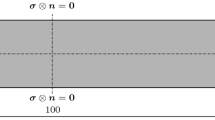Abstract.
A variational formulation is provided for the modified couple stress theory of Yang et al. by using the principle of minimum total potential energy. This leads to the simultaneous determination of the equilibrium equations and the boundary conditions, thereby complementing the original work of Yang et al. where the boundary conditions were not derived. Also, the displacement form of the modified couple stress theory, which is desired for solving many problems, is obtained to supplement the existing stress-based formulation. All equations/expressions are presented in tensorial forms that are coordinate-invariant. As a direct application of the newly obtained displacement form of the theory, a simple shear problem is analytically solved. The solution contains a material length scale parameter and can capture the boundary layer effect, which differs from that based on classical elasticity. The numerical results reveal that the length scale parameter (related to material microstructures) can have a significant effect on material responses.
Similar content being viewed by others
Author information
Authors and Affiliations
Corresponding author
Rights and permissions
About this article
Cite this article
Park, S.K., Gao, XL. Variational formulation of a modified couple stress theory and its application to a simple shear problem. Z. angew. Math. Phys. 59, 904–917 (2008). https://doi.org/10.1007/s00033-006-6073-8
Received:
Revised:
Published:
Issue Date:
DOI: https://doi.org/10.1007/s00033-006-6073-8




